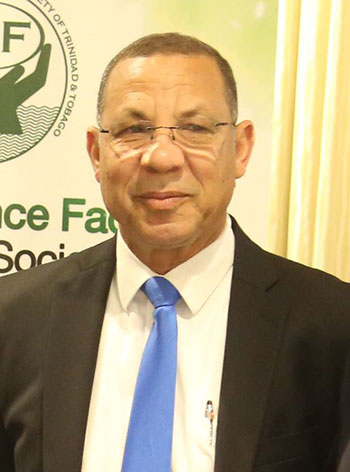(Trinidad Guardian) Twenty-five years ago, in 1999, the Government of T&T’s total expenditure for that fiscal year stood at $10.52 billion. Seven years later, in the 2006 fiscal year, T&T’s expenditure skyrocketed, more than tripling to $37.08 billion.
Even with an adjustment for inflation, which would see that $10.52 billion rise to $19.87 billion, that expenditure would still be less than half the expenditure of the T&T government dating back to 2008.
Between 1999 to 2006, the government’s total expenditure jumped by 252 per cent.
The reason for the rise of that expenditure can be tied to the fact that the country also started seeing increased energy sector revenues. This was mainly as a result of the returns from Atlantic LNG.
“The change really starts off in 1999. It changed, starting in 1999 because (government) revenue goes up. That’s because Atlantic LNG comes on stream. When Atlantic LNG comes on stream, the budget expands. They got more revenue. They found more expenses,” said Mariano Browne, former minister in the Ministry of Finance.
According to Atlantic’s website, “First LNG was produced on April 11, 1999 from Train 1, which would supply three million tonnes of LNG per annum and 6,000 barrels per day (bpd) of natural gas liquids (NGLs).”
Expenditure continued to rise, particularly as Atlantic’s operations began to expand.
Atlantic noted, “On March 13, 2000, the Government and Atlantic signed an agreement for a two-train expansion. Operations commenced with first LNG from Train 2 in August 2002 and from Train 3 in April 2003.
Train 4 was completed in December 2005, making it the largest LNG train in the world at that time, with double the capacity output of Train 1, producing 5.2 mtpa of LNG and 12,000 bpd of natural gas liquids (NGLs). First LNG from Train 4 commenced in May 2007.”
Browne stated, “The spike in revenue and the spike in expenditure, is associated with coming on stream of (Trains) two, three and four.”
This is supported by the Central Bank’s annual report for 2006.
“The nexus of growth emanated from the energy sector, following the commissioning of the Atlantic LNG Train IV facility in December 2005 and the M5000 methanol plant in October 2005,” said the report.
“The other petroleum subsector led the way with real growth of 17.2 per cent, as LNG production was heightened by the introduction of the fourth and largest train, but also from higher crude oil and natural gas production,” according to the report.
Browne explained that some of those returns were placed in investments, most notably the Heritage and Stabilisation Fund which was established in March 2007. It had been previously known as the Interim Revenue Stabilisation Fund (IRSF), set up in 2000, also in the wake of the energy sector recovery which was spurred by Atlantic’s operations.
The HSF was established with US$1.40 billion, an initial transfer from the IRSF.
Apart from that, the government opted to use the increase in revenue to address several outstanding issues.
Browne explained that during that period in the early 2000s, the government’s allocation for transfers and subsidies in particular began to rise with salaries for public servants, which had been subject to a freeze since the late 1980s, being addressed in the early years of the 2000s.
“Expenditure is easy to go up, hard to go down,” said Browne, who noted that in most cases these revenue spikes also came with increased salaries for public sector employees. “A significant percentage of the budget was wages and salaries,” he said.
In the 2003 budget presentation, delivered on October 21, 2002, then Finance Minister and Prime Minister Patrick Manning addressed the issue of a 15-year-old debt to public servants.
Manning said then, “The current expenditure estimates include a one-time payment of $600 million to cover salary arrears. In fact, it is this one-time payment that leads to the overall deficit of $623 million. Excluding this payment, the budget would show a deficit of a mere $23 million. “
If that seems familiar, last year’s budget included a billion-dollar allocation for back pay for public servants as the government sought to settle long outstanding wage agreements with several sectors dating as far back as 2013, with a 4 per cent settlement on offer.
Apart from salaries, major investment was also seen during that period in infrastructure as several major government construction projects received green lights.
Economist Indera Sagewan remembered that period for the start of several of Patrick Manning’s Vision 2020 projects.
“That is a period that is marked by rapid expansion. Rapid expenditure a la mister Manning’s very grand kind of vision for the country. You will recall that would have been the period where we would have had a massive inflows of Chinese workers, the construction of the overpass (at Grand Bazaar),” she said.
“The Hyatt Hotel, that whole Waterfront project. Remember he had plans to do a rapid rail; so significant money would have been spent doing the preliminary feasibility studies.
“He had a plan for the aluminium smelter. You remember that the (TGU) power plant was actually constructed for the aluminium smelter. So significant investment would have gone into there. NAPA, SAPA and the Government Campus Plaza; all of those things were constructed in that period of time,” said Sagewan.
The 2006 Central Bank Annual report also noted the numerous projects which were slated to begin at that time.
“Dominating non-energy activity was growth in the construction sector (17.1 per cent) which was driven by several government projects, such as the government campus, the waterfront project and social infrastructure upgrading,” the report stated.
That period would also see the introduction of the Government Assistance for Tuition Expenses programme (GATE), which was started in 2004. However, 2009 would signal the beginning of a downturn.
In the 2009 fiscal year, total revenue declined by 33 per cent, “primarily because of the decrease in energy revenues occasioned by lower energy prices,” which forced the government to revise its budget estimates on two occasions to cater for lower energy prices,” according to the Central Bank’s Annual Economic Survey for 2009.
Although initially there was a decrease in expected revenue in 2009, expenditure would continue to rise, particularly in the face of another oil boom in the early 2010s and a subsequent adjustment in wages.
“The jump in 2011 in particular, is a 50 per cent jump in the amounts that appeared under transfers and subsidies. That goes up from 15 billion to 30 billion in 2011, “ said Browne.
Since then, the budget expenditure has remained between $48 billion and $61 billion, depending on the volatility of global energy prices, especially the price of LNG.
Twenty-five years on, Atlantic is still a cornerstone of the economy, as in December 2023 the government hailed the successful negotiation of the restructuring of Atlantic’s ownership.
That deal saw bpTT with 45 per cent, Shell 45 per cent with the National Gas Company Ltd (NGC) at 10 per cent—a change from each of the four trains having different ownership structures.
Previously, the government, through wholly state-owned NGC, had 10 per cent stake in Train 1 and 11.11 per cent shareholding in Train 4. Train 1 has been offline since 2020.
In 2006, T&T produced a total average of 3.88 billion cubic feet per day (bcf/d) of natural gas, with 2.01 bcf/d going to produce LNG.
By 2010, the year of T&T’s peak production, the country’s total gas production had risen to an average of 4.33 bcf/d of natural gas, with LNG production rising to 2.32 bcf, according to the consolidated monthly bulletins from the Ministry of Energy.
By 2015, T&T’s total natural gas production was down to 3.83 bcf/d and LNG output had fallen to 2.18 bcf/d. By June 2024, T&T’s total natural gas production had declined to 2.45 bcf/d and LNG output had slipped to 1.09 bcf/d
Concerns about declining natural gas production levels remain.








